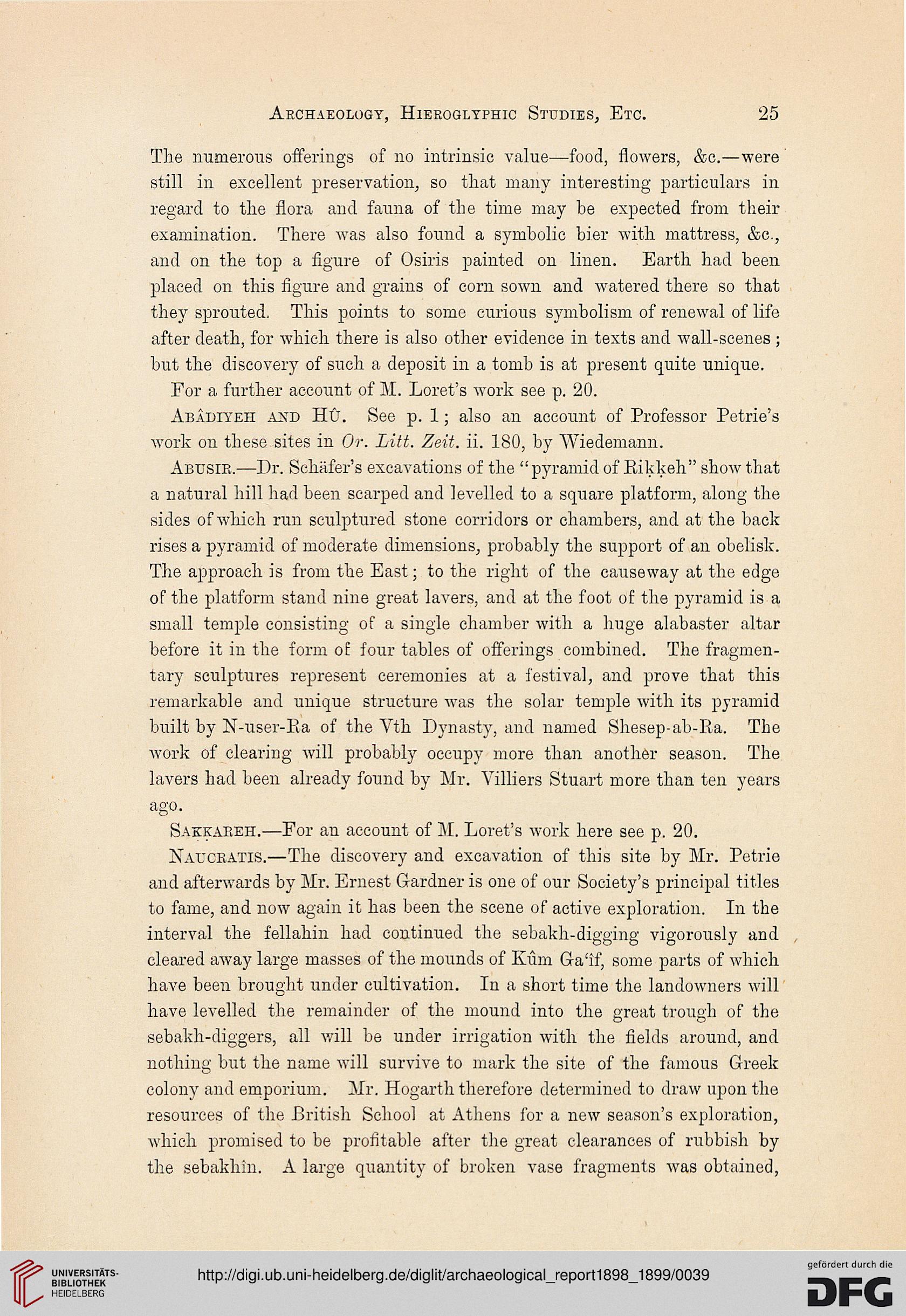Archaeology, Hieroglyphic Studies, Etc.
•25
The numerous offerings of no intrinsic value—food, flowers, &c.—were
still in excellent preservation, so that many interesting particulars in
regard to the flora and fauna of the time may be expected from their
examination. There was also found a symbolic bier with mattress, &c,
and on the top a figure of Osiris painted on linen. Earth had been
placed on this figure and grains of corn sown and watered there so that
they sprouted. This points to some curious symbolism of renewal of life
after death, for which there is also other evidence in texts and wall-scenes ;
but the discovery of such a deposit in a tomb is at present quite unique.
For a further account of M. Loret's work see p. 20.
Abadiyeh axd Hu. See p. 1; also an account of Professor Petrie's
work on these sites in Or. Lilt. Zeit. ii. 180, by "Wiedemann.
Abtjsie.—Dr. Schafer's excavations of the "pyramid of Rikkeh" show that
a natural hill had been scarped and levelled to a square platform, along the
sides of which run sculptured stone corridors or chambers, and at the back
rises a pyramid of moderate dimensions, probably the support of an obelisk.
The approach is from the East; to the right of the causeway at the edge
of the platform stand nine great lavers, and at the foot of the pyramid is a
small temple consisting of a single chamber with a huge alabaster altar
before it in the form of four tables of offerings combined. The fragmen-
tary sculptures represent ceremonies at a festival, and prove that this
remarkable and unique structure was the solar temple with its pyramid
built by N-user-Pia of the Vth Dynasty, and named Shesep-ab-Ra. The
work of clearing will probably occupy more than another season. The
lavers had been already found by Mr. Villiers Stuart more than ten years
ago.
Sakkaeeh.—For an account of M. Loret's work here see p. 20.
Natjcratis.—The discovery and excavation of this site by Mr. Petrie
and afterwards by Mr. Ernest Gardner is one of our Society's principal titles
to fame, and now again it has been the scene of active exploration. In the
interval the fellahin had continued the sebakh-digging vigorously and
cleared away large masses of the mounds of Kum Ga'if, some parts of which
have been brought under cultivation. In a short time the landowners will
have levelled the remainder of the mound into the great trough of the
sebakh-diggers, all will be under irrigation with the fields around, and
nothing but the name will survive to mark the site of the famous Greek
colony and emporium. Mr. Hogarth therefore determined to draw upon the
resources of the British School at Athens for a new season's exploration,
which promised to be profitable after the great clearances of rubbish by
the sebakhin. A large quantity of broken vase fragments was obtained,
•25
The numerous offerings of no intrinsic value—food, flowers, &c.—were
still in excellent preservation, so that many interesting particulars in
regard to the flora and fauna of the time may be expected from their
examination. There was also found a symbolic bier with mattress, &c,
and on the top a figure of Osiris painted on linen. Earth had been
placed on this figure and grains of corn sown and watered there so that
they sprouted. This points to some curious symbolism of renewal of life
after death, for which there is also other evidence in texts and wall-scenes ;
but the discovery of such a deposit in a tomb is at present quite unique.
For a further account of M. Loret's work see p. 20.
Abadiyeh axd Hu. See p. 1; also an account of Professor Petrie's
work on these sites in Or. Lilt. Zeit. ii. 180, by "Wiedemann.
Abtjsie.—Dr. Schafer's excavations of the "pyramid of Rikkeh" show that
a natural hill had been scarped and levelled to a square platform, along the
sides of which run sculptured stone corridors or chambers, and at the back
rises a pyramid of moderate dimensions, probably the support of an obelisk.
The approach is from the East; to the right of the causeway at the edge
of the platform stand nine great lavers, and at the foot of the pyramid is a
small temple consisting of a single chamber with a huge alabaster altar
before it in the form of four tables of offerings combined. The fragmen-
tary sculptures represent ceremonies at a festival, and prove that this
remarkable and unique structure was the solar temple with its pyramid
built by N-user-Pia of the Vth Dynasty, and named Shesep-ab-Ra. The
work of clearing will probably occupy more than another season. The
lavers had been already found by Mr. Villiers Stuart more than ten years
ago.
Sakkaeeh.—For an account of M. Loret's work here see p. 20.
Natjcratis.—The discovery and excavation of this site by Mr. Petrie
and afterwards by Mr. Ernest Gardner is one of our Society's principal titles
to fame, and now again it has been the scene of active exploration. In the
interval the fellahin had continued the sebakh-digging vigorously and
cleared away large masses of the mounds of Kum Ga'if, some parts of which
have been brought under cultivation. In a short time the landowners will
have levelled the remainder of the mound into the great trough of the
sebakh-diggers, all will be under irrigation with the fields around, and
nothing but the name will survive to mark the site of the famous Greek
colony and emporium. Mr. Hogarth therefore determined to draw upon the
resources of the British School at Athens for a new season's exploration,
which promised to be profitable after the great clearances of rubbish by
the sebakhin. A large quantity of broken vase fragments was obtained,





